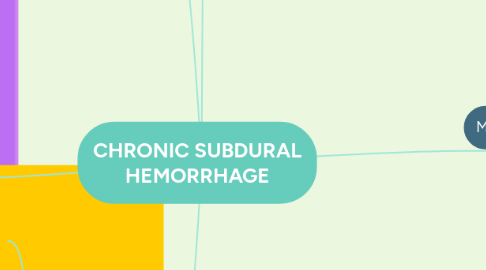
1. Definition
1.1. Onset
1.1.1. 3 weeks to months
1.2. Bleeding is less profuse
1.3. Compression of the intracranial contents
1.4. Blood changes
1.4.1. 2 to 4 days
1.4.1.1. Thicker and Darker
1.4.2. Few weeks
1.4.2.1. Clot breaks down
1.4.2.1.1. Color and consistency changes
1.4.3. Calcification or ossification
1.4.4. Clinical symptoms flactuate
2. Diagnostic
2.1. MRI
2.2. PET Scan
2.3. CT Scan
3. Symptoms
3.1. Several intermittent headache
3.2. Focal CNS
3.2.1. Horner Syndrome
3.2.2. Loss of coordination
3.2.3. Poor gag reflex
3.2.4. Speech or language deficits
3.2.5. Vision changes
3.3. Personality changes
3.4. Focal seizures
4. Management
4.1. Surgical Management
4.1.1. Craniotomy
4.1.2. multiple burr holes
4.2. Medications
4.2.1. Anticonvulsants
4.2.2. Corticosteroids
4.3. Nursing Management
4.3.1. Assess
4.3.1.1. Neurologic status
4.3.1.1.1. History of unconsciousness
4.3.1.2. Neurologic funtion
4.3.1.2.1. Level of Consciousness
4.3.1.2.2. Vital signs
4.3.2. Nursing Interventions
4.3.2.1. Patent airway
4.3.2.1.1. Elevate HOB
4.3.2.1.2. Sunctioning
4.3.2.1.3. ABG values
4.3.2.1.4. Mechanical ventilation
4.3.2.2. Nutritional, fuid and electrolyte balance
4.3.2.2.1. Tube feedings
4.3.2.2.2. Insulin administration
4.3.2.3. Adequate CPP
4.3.2.3.1. ↑ HOB, IV fluids, or Vasporessors

